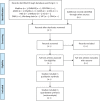Herbal medicine for acute management and rehabilitation of traumatic brain injury: A protocol for a systematic review
- PMID: 30653148
- PMCID: PMC6370117
- DOI: 10.1097/MD.0000000000014145
Herbal medicine for acute management and rehabilitation of traumatic brain injury: A protocol for a systematic review
Abstract
Background: This systematic review protocol describes the methods that will be used to evaluate the efficacy and safety of herbal medicine in treating traumatic brain injury.
Methods and analysis: The following electronic databases will be searched up to December 2018 without language or publication status restrictions: Medline, EMBASE, the Cochrane Central Register of Controlled Trials, Allied and Complementary Medicine Database, and Cumulative Index to Nursing and Allied Health Literature. We will also search Korean, Chinese, and Japanese databases. Any randomized controlled trials related to herbal medicine for traumatic brain injury will be included. The functional outcome, consciousness state, morbidity, and mortality will be assessed as primary outcomes. The quality of life, adverse events, and total effective rate will be evaluated as secondary outcomes. Two researchers will independently perform the study selection, data extraction, assessment of study quality, and evaluation of the quality of evidence for the main findings. Data synthesis and analysis will be performed using RevMan version 5.3. The results will be expressed as a risk ratio for the binary outcome and as the mean difference or standardized mean difference for a continuous outcome. We will synthesize the data by either fixed effects or random effects model according to a heterogeneity test or the number of studies included in the meta-analysis. The methodological quality of the included studies will be evaluated using the Cochrane Collaboration's risk of bias tool. The quality of evidence for each main outcome will be evaluated using the Grading of Recommendations Assessment, Development, and Evaluation approach.
Ethics and dissemination: Ethical approval is not required because individual patient data are not included. The findings of this systematic review will be disseminated through a peer-reviewed publication or conference presentations.
Prospero registration number: CRD42018116559.
Conflict of interest statement
The authors have no conflicts of interest to declare.
Figures

Similar articles
-
Herbal medicine Sihogayonggolmoryeo-tang or Chai-Hu-Jia-Long-Gu-Mu-Li-Tang for the treatment of post-stroke depression: A protocol for a systematic review and meta-analysis.Medicine (Baltimore). 2018 Sep;97(38):e12384. doi: 10.1097/MD.0000000000012384. Medicine (Baltimore). 2018. PMID: 30235703 Free PMC article.
-
Herbal medicine for cervicogenic dizziness: A protocol for a systematic review and meta-analysis.Medicine (Baltimore). 2020 Dec 18;99(51):e23852. doi: 10.1097/MD.0000000000023852. Medicine (Baltimore). 2020. PMID: 33371169 Free PMC article.
-
Herbal medicine on cancer-related fatigue of lung cancer survivors: Protocol for a systematic review.Medicine (Baltimore). 2020 Jan;99(5):e18968. doi: 10.1097/MD.0000000000018968. Medicine (Baltimore). 2020. PMID: 32000424 Free PMC article.
-
Xiao Chai Hu Tang, a herbal medicine, for chronic hepatitis B.Cochrane Database Syst Rev. 2019 Nov 7;2019(11):CD013090. doi: 10.1002/14651858.CD013090.pub2. Cochrane Database Syst Rev. 2019. PMID: 31697415 Free PMC article.
-
Efficacy and safety of herbal medicine treatment on postsurgical recovery in gastric cancer patients: A systematic review and meta-analysis.Medicine (Baltimore). 2025 Jan 3;104(1):e41034. doi: 10.1097/MD.0000000000041034. Medicine (Baltimore). 2025. PMID: 40184097 Free PMC article.
Cited by
-
A Review of Advances in Multimodal Treatment Strategies for Chronic Disorders of Consciousness Following Severe Traumatic Brain Injury.Int J Gen Med. 2025 Feb 14;18:771-786. doi: 10.2147/IJGM.S502086. eCollection 2025. Int J Gen Med. 2025. PMID: 39967766 Free PMC article. Review.
-
A Novel Network Pharmacology Strategy Based on the Universal Effectiveness-Common Mechanism of Medical Herbs Uncovers Therapeutic Targets in Traumatic Brain Injury.Drug Des Devel Ther. 2024 Apr 16;18:1175-1188. doi: 10.2147/DDDT.S450895. eCollection 2024. Drug Des Devel Ther. 2024. PMID: 38645986 Free PMC article.
-
A Direct Relationship Between 'Blood Stasis' and Fibrinaloid Microclots in Chronic, Inflammatory, and Vascular Diseases, and Some Traditional Natural Products Approaches to Treatment.Pharmaceuticals (Basel). 2025 May 12;18(5):712. doi: 10.3390/ph18050712. Pharmaceuticals (Basel). 2025. PMID: 40430532 Free PMC article. Review.
-
Herbal Medicine for Traumatic Brain Injury: A Systematic Review and Meta-Analysis of Randomized Controlled Trials and Limitations.Front Neurol. 2020 Sep 18;11:772. doi: 10.3389/fneur.2020.00772. eCollection 2020. Front Neurol. 2020. PMID: 33071922 Free PMC article.
-
Targeting Nrf2-Mediated Oxidative Stress Response in Traumatic Brain Injury: Therapeutic Perspectives of Phytochemicals.Oxid Med Cell Longev. 2022 Apr 4;2022:1015791. doi: 10.1155/2022/1015791. eCollection 2022. Oxid Med Cell Longev. 2022. PMID: 35419162 Free PMC article. Review.
References
-
- Menon DK, Schwab K, Wright DW, et al. Demographics and Clinical Assessment Working Group of the International and Interagency Initiative toward Common Data Elements for Research on Traumatic Brain Injury and Psychological Health. Position statement: definition of traumatic brain injury. Arch Phys Med Rehabil 2010;91:1637–40. - PubMed
-
- Nguyen R, Fiest KM, McChesney J, et al. The international incidence of traumatic brain injury: a systematic review and meta-analysis. Can J Neurol Sci 2016;43:774–85. - PubMed
-
- Faul M, Xu L, Wald MM, et al. Traumatic brain injury in the United States: emergency department visits, hospitalizations and deaths 2002–2006. 2010;Atlanta (GA): Centers for Disease Control and Prevention, National Center for Injury Prevention and Control, Available at: https://www.cdc.gov/traumaticbraininjury/pdf/tbi_blue_book_externalcause... [Accessed on October 2018].
-
- Majdan M, Plancikova D, Brazinova A, et al. Epidemiology of traumatic brain injuries in Europe: a cross-sectional analysis. Lancet Public Health 2016;1:e76–83. - PubMed
MeSH terms
LinkOut - more resources
Full Text Sources
Medical

